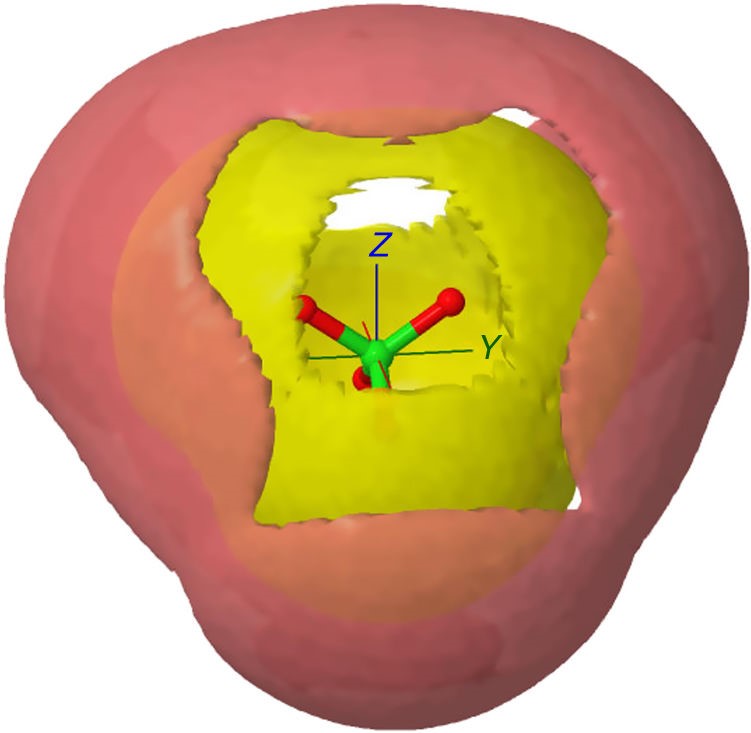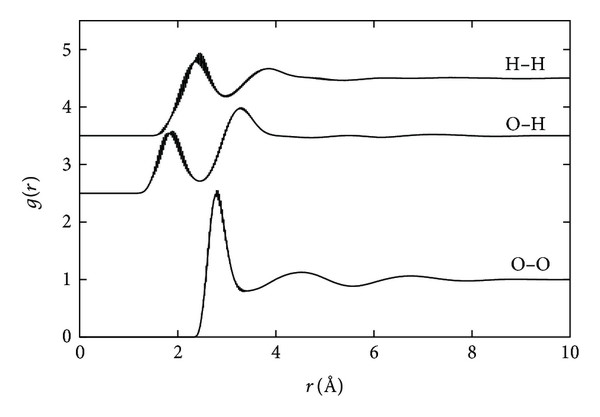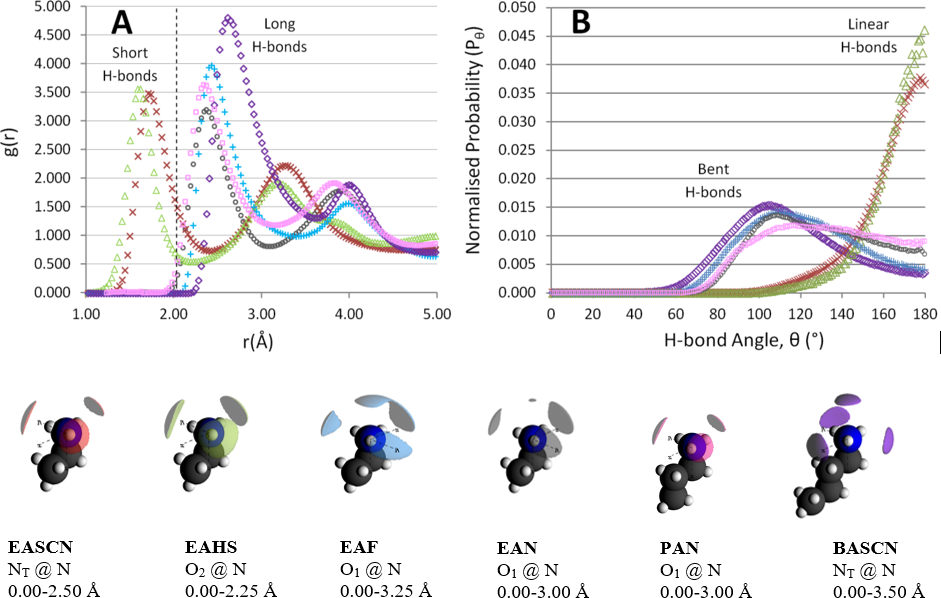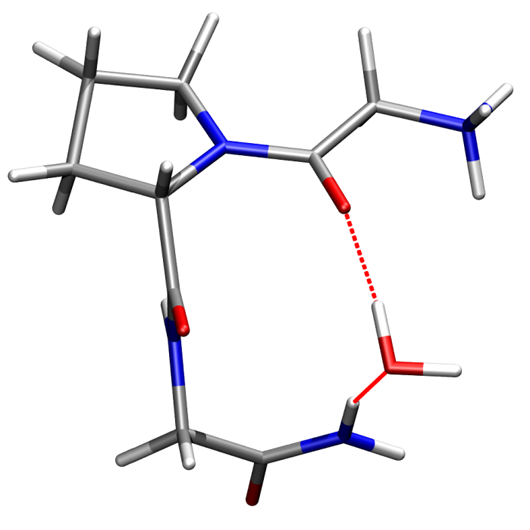Water and aqueous solutions
S. Lenton, N. H. Rhys, J. J. Towey, A. K. Soper and L. Dougan, Highly compressed water structure observed in a perchlorate aqueous solution. Nat. Commun., 2017, 8, 919.
One of the assumed pre-requisites for the existence of extra-terrestrial life is the presence of liquid water. Recently NASA's Phoenix Mars Lander discovered perchlorate in the Martian soil. At high enough concentrations (~44 wt%) magnesium perchlorate salts can reduce the freezing temperature of water to as low as 206 K, and therefore provide the means for water to remain liquid on the Martian surface. Neutron scattering data from SANDALS was collected from these high concentration magnesium perchlorate solutions, with analysis using EPSR giving an understanding of the structural changes that allow the solution to remain liquid at such low temperatures. It was observed that cation to anion association is mediated by water molecules and causes a major disruption to water structure. This disruption is the equivalent to a pressure in pure water of the order 2 GPa. To a marked extent water–water hydrogen bonds in the pure liquid are replaced by cation-water-anion bonds in solution, thus resulting in the very deep eutectic point of this solution. The study, and its potential implications the existence of life on Mars, were quickly picked up by the popular press, including in online versions of the Daily Mail,[1] The Sun[2] and The Express.[3]

Distributions of water and magnesium around the perchlorate ion. Distribution of water (yellow) and magnesium (red) around the perchlorate ion in Mg(ClO4)2 aqueous solutions. For the water distribution the contour encloses 30% of the water molecules in the distance range 0–5 Å. For magnesium the contour encloses 30% of the magnesium atoms in the distance range 0–7 Å.
[1]http://www.dailymail.co.uk/sciencetech/article-4977154/Salty-solution-Mars-harbouring-microbial-life.html, accessed 26/10/17
[2] https://www.thesun.co.uk/tech/4682533/life-may-exist-on-mars-study/ accessed 26/10/17
[3] http://www.express.co.uk/news/science/867168/life-on-mars-aliens-red-planet-discovery-university-of-leeds accessed 26/10/17
A. K. Soper, The Radial Distribution Functions of Water as Derived from Radiation Total Scattering Experiments: Is There Anything We Can Say for Sure?, ISRN Phys. Chem., 2013, 2013, 279463.
This seminal paper focuses in particular on the complex inelasticity corrections required for correct interpretation of data from samples containing light hydrogen. The paper makes a comparison among six data sets from SANDALS and NIMROD and provides a structure with an error bar, thanks to the application of a self-consistent method for inelasticity corrections (now implemented in Gudrun).

Site-site radial distribution functions for water at 300 K (lines) and their estimated RMS deviations (error bars), based on the average of six simulations (described in detail in the paper above).
F. Bruni, S. Imberti, R. Mancinelli, and M. A. Ricci, Aqueous solutions of divalent chlorides: Ions hydration shell and water structure, Chem. Phys., 2012, 136, 64520.
Last in a series of studies/papers performed on SANDALS on electrolytic solutions (including acids, bases and salts), this paper investigates divalent cations and their hydration shells, exploiting the great sensitivity of the instrument to water and its structure. The hydration shell of divalent cations has been found to be more rigid and stable in time compared to monovalent ions. On the other hand, this first neighbour layer of water molecules becomes quite effective at screening the strong electrostatic field of divalent cations. As a consequence, beyond the first shell, the overall effect on the microscopic structure of water (measured in terms of shortening of the second peak in the water oxygen to water oxygen correlation) is comparable to the one generated by monovalent ions.
Ionic liquids
R. Hayes, S. Imberti, G. G. Warr, and R. Atkin, The nature of hydrogen bonding in protic ionic liquids, Angew. Chemie Int. Ed., 2013, 52, 4623–4627.
Protic ionic liquids (PILs) are an emerging class of solvents composed entirely of ions, and for which H-bonds are a hallmark of their structure. In this particular example, the ability of SANDALS to see hydrogen and therefore to define the geometrical properties of the hydrogen bonds present in the liquids (length and angle) has allowed to divide a set of 6 PILs in two classes, also related to their macroscopic properties. The ionic liquids (EASCN and EAHS)* with strong (short and directional) hydrogen bonds are more “solid-like", meaning for example higher melting points, whilst the ionic liquids (EAF, EAN, PAN and BASCN)* with weaker (longer and more bent) hydrogen bonds are more “liquid-like" with lower melting points. *ethylammonium thiocyanate, ethylammonium hydrogen sulfate, ethylammonium formate, ethylammonium nitrate, propylammonium nitrate and butylammonium thiocyanate.

EASCN (red crosses), EAHS (green triangles), EAF (blue pluses), EAN (black circles) PAN (pink rectangles) & BASCN (purple diamonds). H-bond distances: (A) partial radial HN∙∙∙X g(r) data. H-bond angles: (B) normalized angle distributions plot of N-HN∙∙∙X triplet for all H-bond lengths up to the first local minimum in the g(r) data in A. H-bond distance + angle: (C–H) sdf plots of H-bond acceptor location as a function of distance & angular position from the H-bond donor (ammonium nitrogen). The sdf data is a combined 3D representation of (A) & (B) with 20% probability surfaces shown.
R. Hayes, S. Imberti, G. G. Warr, and R. Atkin, How water dissolves in protic ionic liquids, Angew. Chemie Int. Ed., 2012, 51, 7468–7471.
PILs with amphiphilic cations present segregation phenomena, in a similar way to aqueous surfactant mesophases. H/D substitution has been used to enhance the contrast between the ionic and nonionic regions. Additionally, SANDALS is very sensitive to microscopic structuring down to 0.1 Å. Water is the most common impurity in ILs, with even nominally hydrophobic ILs absorbing significant quantities of water when exposed to the atmosphere. It is found that EAN-water solutions maintain most of the self-assembled structure of pure EAN, in a fashion similar to surfactant solutions, but on a length scale an order of magnitude smaller. A well-defined interface exists, consisting of the nonpolar ethyl groups on one side, and amino cation, nitrate anion, and water on the other side.
Catalysts and other functional materials
M. Serrano-Ruiz, S. Imberti, L. Bernasconi, N. Jadagayeva, F. Scalambra and A. Romerosa, Study of the interaction of water with the aqua-soluble dimeric complex [RuCp(PTA)2-μ-CN-1κC:2κ(2)N-RuCp(PTA)2](CF3SO3) (PTA = 1,3,5-triaza-7-phosphaadamantane) by neutron and X-ray diffraction in solution., Chem. Commun., 2014, 50, 11587–11590.
Organometallic coordination compounds are potential candidates for a variety of applications such as non-linear optical devices, electrocatalysis, photocatalysis, photovoltaics and template formation. A particular class of water-soluble ruthenium compounds has been studied on SANDALS, thanks to its ability to resolve the structure of water. Combining ab initio simulations with neutron diffraction on SANDALS, water was found to interact not only with the hydrophilic ligands (PTA) but also with the hydrophobic one (Cp), thus modifying the electronic properties of the molecule. Calculations of the UV-vis absorption spectra using the output from EPSR simulations provided good comparison with the experimental results, thus providing a proof of concept.
E. L. Bennett, T. Wilson, P. J. Murphy, K. Refson, A. C. Hannon, S. Imberti, S. K. Callear, G. A. Chass and S. F. Parker, Structure and spectroscopy of CuH prepared via borohydride reduction, Acta Crystallogr. Sect. B Struct. Sci., 2015, 71, 608–612.
E. Bennett, T. Wilson, P. J. Murphy, K. Refson, A. C. Hannon, S. Imberti, S. K. Callear, G. A. Chass and S. F. Parker, How the Surface Structure Determines the Properties of CuH, Inorg. Chem. 54, 2213–2220 (2015).
Copper hydride (CuH) is a material that appears in a wide diversity of circumstances ranging from catalysis to electrochemistry to organic synthesis. There are both aqueous and non-aqueous synthetic routes to CuH apparently giving different results. The Cu-H bonding distance was investigated by applying H/D substitution and compared to calculations in the crystalline state. The stability of the instrument also allowed accurate first order differences to be calculated. The results from SANDALS, complemented by inelastic neutron scattering, show that, while all methods for the synthesis of CuH result in the same bulk product, the synthetic path taken engenders differing surface properties.
Self-assembly
D. T. Bowron and K. J. Edler, Decyltrimethylammonium bromide micelles in acidic solutions : counterion binding, water structuring and micelle shape, Langmuir, 2017, 33, 262–271.
D. T. Bowron and K. J. Edler, Combining wide-angle and small-angle scattering to study colloids and self-assembly, Curr. Opin. Colloid Interface Sci., 2015, 20, 227–234.
The ability of SANDALS to investigate the structure of aqueous solutions with atomic resolution to nanometre length scales, has enabled the instrument to provide some remarkable new insight into the intermolecular interactions that underpin the technologically important field of molecular self-assembly. A recent example of this type of work can be found in a study that determined the effect of strong acids on solutions of decyltrimethylammonium bromide. This study found that the addition of either hydrobromic or hydrochloric acid to an acid-free reference solution significantly reduced the size of the self-assembled surfactant micelles, although in contrast to HCl, HBr was found to enhance the development of more compact, dehydrated and spherical structures where the counterions are more tightly bound to the exposed surfactant headgroups.
Biological molecules in solution
S. Busch, C. D. Bruce, C. Redfield, C. D. Lorenz and S. E. McLain, Water Mediation Is Essential to Nucleation of β-Turn Formation in Peptide Folding Motifs, Angew. Chemie Int. Ed., 2013, 52, 13091–13095.
The ability of SANDALS to resolve the structure of hydrogen-containing fluids has proved capable, when combined with complementary NMR spectroscopy, to obtain information on intra-molecular bonds for molecules in solution. The glycine-proline-glycine sequence in the peptide GPG-NH2, known to occur in beta-turns proteins, has been studied in water. Evidence has been found for a distribution of direct and (1-2 molecules) water mediated intra-molecular hydrogen bonds joining the C=O...H-N groups of the peptide. An extremely important consequence of this study is to highlight the importance of hydrophilic interaction in driving protein folding in addition to the hydrophobic effect.

Model of the GPG-NH2 peptide and water showing a water-mediated peptide folding interaction. The single bridging water is shown interacting with an oxygen molecule and with the NH2 group.
A. J. Johnston, S. Busch, L. C. Pardo, S. K. Callear, P. Biggin and S. McLain, On the Atomic Structure of Cocaine in Solution, Phys. Chem. Chem. Phys., 2015, 4, 1166–1169.
Molecules which passively diffuse across the blood-brain barrier (BBB) are usually required to possess the correct balance between lipophilicity, to traverse this largely hydrophobic barrier, and hydrophilicity, to subsequently move towards the aqueous environment of the interstitial brain fluid. Cocaine is a naturally occurring alkaloid, with a great flexibility, and for this reason many theories exist as to what conformation or even if a change of conformation is the secret to this great capability to cross the BBB. This study on the hydration of cocaine is one of the most sophisticated examples of the capabilities of neutron diffraction on SANDALS, together with NMR and EPSR simulation, to predict simultaneously the intramolecular structure, the role of solvating water molecules and the degree of affinity for hydrogen bonding of different molecular sites. Cocaine is found to prefer a closed conformation, with a water mediated internal hydrogen bond, which in turn allows a unique balance among hydrophilic/phobic sites to be obtained.
Solvated electrons
A. G. Seel, H. Swan, D. T. Bowron, J. C. Wasse, T. Weller, P. P. Edwards, C. A. Howard, and N. T. Skipper, Electron Solvation and the Unique Liquid Structure of a Mixed-Amine Expanded Metal: The Saturated Li–NH3–MeNH2 System, Angew. Chem. Int. Ed., 2017, 56, 1561-1565.
Alkali metals exhibit an exceptional solubility in ammonia (NH3): the low concentration solutions present electrolytic properties, whereby the metal valence electrons have been ionised into solution and exist as solvated electrons propagating between solvent cavities. Increasing the concentration results in metallization in the liquid phase. Lithium also solvates in MeNH2 with similar behaviour, but the concentration at which the metallization occurs is very different in the two liquids. H/D and 6Li/natLi substitution was exploited to study the Li-NH2-MeNH2 mixture which was found to be a highly structured homogeneous liquid metal, with electron hosting cavities.
Our Science Highlight articles cover the diverse research that takes place at our facility. Read all our Science Highlight articles using SANDALS below:
